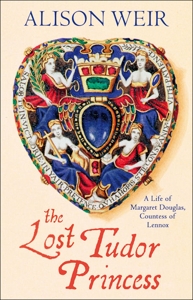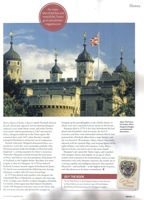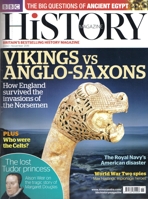Books
The Lost Tudor Princess: The Life of Margaret Douglas, Countess of Lennox

"What a story! What a life! I could hardly believe what I was reading: Margaret seemed to have been at the centre of a whole era of English history, and making the same foolish but very human mistakes again and again. And what a splendidly wicked villain the tale has in the shape of Thomas Bishop."
"I am so enjoying Margaret Douglas’ amazing life story. It’s like a novel for me. I knew little of this history, so I read it with fascination as to what is going to happen next! What a fabulous idea for a subject, and how well you put this complicated story together."
(Comments from my British and American commissioning editors after reading the book.)
"A magnificent and thorough study by a sharp historian." (Daily Mail MUST READ column)
"Weir [is] a surprisingly sober historian for one so popular; her books are admirable for their research... A refreshing perspective on an otherwise familiar period of British history." (The Times)
"Weir's book is Tudor history Blue-Ray style... Judiciously weighing every piece of evidence, Weir balances historical data with emotional speculation to illuminate the ferocious dynastis ambitions and will to power that earned her subject a place in the spotlight." (The New York Times Book Review)
"Weir provides copious evidence and minute documentation of the betrayals, plots, incendiary gossip, and shifting alliances that characterized Elizabethan England. Excerpts from Margaret's letters show her to be politically savvy, manipulative, and fierce. An abundantly detailed history from an author steeped in England's past." (Kirkus Reviews)
"Alison Weir has done us a favor by reviving the story of this extraordinary woman who loved passionately, was imprisoned four times and built a dynasty over four reigns. This is a substantial, detailed biography of a fascinating woman who lived her extraordinary life to the full, taking desperate chances for love and for ambition. It will appeal to anyone with an interest in the powerful women of the Tudor period.” (Philippa Gregory, The Washington Post)
"In this noteworthy biography, Weir shows how Lady Margaret Douglas frequently ignored her own safety to further her ambition. Love caused Margaret great problems, and led to her uncle [Henry VIII] passing a famously troublesome bill of attainder that she repeatedly violated. What’s perhaps of greatest interest, readers see from Margaret’s perspective the poignant story of her elder son, the infamous Lord Darnley, and his marriage to Mary, Queen of Scots. Through considerable research and with great clarity, Weir reveals how the strong-willed Margaret encapsulated the best and worst of the ambitious Tudor dynasty—stubbornness, passion, tragedy, courage—while leading a fascinating life of her own, to the detriment of England’s well-being." (Publishers Weekly)
"With a fine eye for period detail, Weir chronicles the romances, scandals and intrigues that saw five Tudor reigns." (The Lady)
"A fascinating story... Weir brings this astonishing and wild woman to glorious life." (Kate Williams in Metro)
“This is a substantial, detailed biography of a fascinating woman who lived her extraordinary life to the full, taking desperate chances for love and for ambition. It will appeal to anyone with an interest in the powerful women of the Tudor period.” (Philippa Gregory, The Washington Post)
"The reliably readable Alison Weir shines a spotlight upon the life of Margaret Douglas [and] captures a lifetime spanning five Tudor reigns.' (Daily Express)
"Alison Weir brings this captivating character out of the shadows and presents a strong, capable woman who operated effectively and fearlessly at the very highest levels of power." (BookBub)
"The book and its narration are both highly recommended." (Sound Commentary.com, audio book starred review)
"Weir has compiled her biography in dazzling, granular detail." (New York Times Book Review, for the paperback edition)
Editor's choice, THE BOOK PEOPLE.
Named one of the best 6 history books of 2015 by The Independent

Above: US jacket

Above: UK paperback jacket
Royal Tudor blood ran in her veins. Her mother was a queen, and she herself was the granddaughter, niece, cousin and grandmother of monarchs. Some thought she should be queen of England. Beautiful and tempestuous, she defied her uncle, Henry VIII, and created scandal by indulging in two illicit relationships. She was forgiven and served five of Henry’s wives. The marriage arranged for her turned into a love match. A born political intriguer, she was imprisoned in the Tower of London on several occasions. She helped to bring about one of the most notorious royal marriages of the sixteenth century, but it brought her only tragedy. Her son and her husband were brutally murdered, and there were rumours that she herself was poisoned. She warred with two queens, Mary of Scotland and Elizabeth of England. A brave survivor, Lady Margaret Douglas, Countess of Lennox, was a prominent and important figure in Tudor England, and yet today she is largely forgotten. Her story deserves to be better known.
She was the daughter of Henry VIII’s sister, Margaret Tudor (daughter of Henry VII and queen of James IV of Scots), by her second husband, the Earl of Angus. Margaret was their only child. Born in Northumberland in 1515, she had claim to the English throne, but was excluded from the succession in 1544 when England was at war with Scotland. Nevertheless, she remained a dynastic threat to the Tudors, especially Elizabeth I.
The only child of a broken marriage - about which Henry VIII had much to say - she became a lady-of-honour to Anne Boleyn. But in 1536, just after Anne's execution, it was discovered that Margaret had secretly precontracted herself to Lord Thomas Howard, son of the Duke of Norfolk. Both were imprisoned in the Tower and sentenced to death by Act of Attainder. The Act also expressly forbade any member of the royal family to marry without royal assent.
But Henry VIII contented himself with keeping the couple in prison. Margaret was released in November 1537. Love poems written by her and Thomas survive as a poignant reminder of a doomed romance.
Yet Margaret failed to learn a lesson from this. In 1541 she again incurred Henry's displeasure when she had an affair with Charles Howard, the brother of Katherine Howard, the King's fifth wife.
By 1544 Margaret was back in favour, and Henry VIII arranged for her to marry Matthew Stewart, Earl of Lennox, a Scottish traitor exiled to England, and a cultivated man who had spent years in France. It turned out to be a love match. A pendant, the Lennox Jewel, bearing testimony to the couple's devotion and ambitions, survives in the Royal Collection. Sadly, of their eight children, only two survived infancy: Henry, Lord Darnley, and Charles, Earl of Lennox. Through her marriage Margaret, a determined intriguer and a very feisty lady, became deeply involved in Anglo-Scottish politics.
A staunch Catholic, she was prominent at the court of Mary I, her life-long friend, who wanted Margaret to succeed her instead of the Protestant Elizabeth, the bastard half-sister whom Mary feared. It did not come to pass, and as soon as Elizabeth became queen in 1558, Margaret retired to her house at Temple Newsham in Yorkshire, which became a focus for Catholic intrigues. Margaret’s chief aim was to marry her son, Lord Darnley, to Mary, Queen of Scots, a plan to which Elizabeth was opposed. Consequently Margaret found herself imprisoned, and she was sent to the Tower when Darnley went north in 1565 and married Queen Mary without Elizabeth's permission. In 1567 Darnley's murder prompted Elizabeth to release Margaret for compassionate reasons.
Racked with grief, Margaret denounced Mary as a murderess, but some years later they were reconciled, after Margaret had come to believe that Mary was innocent. But there were more tragedies and dangerous intrigues in store.
Margaret’s tale spans five Tudor reigns. In an age in which women were expected to be insubordinate to men, and to occupy themselves chiefly with domestic concerns, she stands out as a strong, capable and intelligent lady who operated effectively – and fearlessly - at the very highest levels of power. The sources for her life are rich and varied; in writing her biography I have built on research I did some years ago, which was sufficient to show that hers is a story worth telling.
This book was originally titled The Princess of Scotland, but Margaret Douglas was indeed 'the lost Tudor Princess'; her story has been buried within those of her more famous contemporaries, and much misunderstood, and yet it spans five reigns and provides us with a better understanding of the Tudor story.








Preliminary jacket designs.

You can hear me speaking about Margaret Douglas on The Ofdie's audioboom website here:
https://audioboom.com/posts/3893066-alison-weir-on-the-lost-tudor-princess-a-life-of-margaret-douglas-countess-of-lennox?t=0
You can read my interview about Margaret Douglas with the delightful Beth von Staats of Queen Anne Boleyn Historical Writers here:
http://queenanneboleyn.com/2015/12/18/qab-interview-with-the-delightful-alison-weir/
THE PRINCESS OF SCOTLAND: A LIFE OF MARGARET DOUGLAS IN THE WORKS
from Nerdalicious, December 2013
Best-selling author Alison Weir has announced her next non-fiction book. The Princess of Scotland, will focus on the life of Margaret Douglas, Countess of Lennox. Margaret Douglas was the daughter of Henry VIII’s older sister, Margaret Tudor, Queen Dowager of Scotland and Archibald Douglas, 6th Earl of Angus. When her parents faced difficulties in Scotland Margaret was sent to the household of her godfather, Cardinal Wolsey, and after his death she joined the household of Princess Mary Tudor until she was appointed a lady-in-waiting to Anne Boleyn. An heir to the throne after King Henry VIII had bastardised both of his own daughters, Margaret incurred the king’s wrath twice, first for her unauthorised engagement to Lord Thomas Howard and again in 1541 for an affair with Thomas Howard’s nephew, Charles Howard, the brother of Queen Katherine Howard. Her career spanned the reign of four Tudor monarchs. She clashed with both Mary, Queen of Scots, and Elizabeth I, and she was instrumental in securing the Stuart succession to the throne of England for her grandson, James I.
Alison Weir thinks it is time for her story to be told. Alison told us: “I’ve wanted to write about Margaret Douglas since 1974, when I did a lot of research on her, but since then other projects have taken precedence. A good friend of mine, Siobhan Clarke, a costumed guide lecturer at Hampton Court, guides in costume as Margaret Douglas, as well as lecturing on her. Hearing Siobhan revived my interest at a time when the field of Tudor biography was becoming crowded and all the major royal figures were already the subjects of biographies. It occurred to me that Margaret Douglas, a feisty political operator whose tumultuous life spanned much of the Tudor period, deserved to be better known. It seemed to me that Siobhan Clarke was the ideal person to write her biography, and I tried to persuade her to put pen to paper, but she has very generously urged me to do so instead, because she agrees with me that Margaret’s profile needs to be raised. When I put the idea to my publishers they jumped at it, seeing immediately that the life of Margaret Douglas provides many missing links in the Tudor story.”
(http://nerdalicious.com.au/books/alison-weirs-the-princess-of-scotland-a-life-of-margaret-douglas-in-the-works/)
On 29th September I was a guest on BBC's Woman's Hour, talking about The Lost Tudor Princess. You can hear the interview at http://www.bbc.co.uk/programmes/b06d2g8v.





You can read my articles about Margaret Douglas in the November/December 2015 issue of Britain magazine (above) and the November edition of BBC History Magazine (below).





Read my article, '"You seem all my pleasure": The Lennox Jewel' here at tudortimes.co.uk/guest-articles/you-seem-all-my-pleasure-the-lennox-jewel on the fabulous Tudor Times website.




